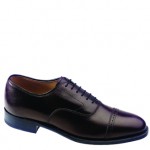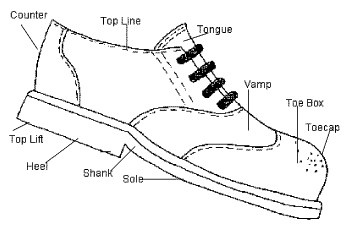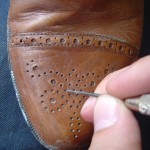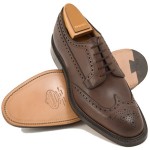The Absolute Guide to Dress Shoes
Written by admin, Friday, January 16th, 2009 in Fashion, The Style Guide One of the biggest ways to make or break an outfit is the shoes that go with it. As ridiculous as it sounds, shoes are sometimes the best indicator of quality in an outfit- many a wonderful outfit (especially many suits) have been ruined by an absolutely horrible choice in shoes. Frankly, there is nothing that irritates me more than seeing someone in an otherwise wonderful suit wearing huge, bulky (“old man”-ish) loafers- it ruins everything.
One of the biggest ways to make or break an outfit is the shoes that go with it. As ridiculous as it sounds, shoes are sometimes the best indicator of quality in an outfit- many a wonderful outfit (especially many suits) have been ruined by an absolutely horrible choice in shoes. Frankly, there is nothing that irritates me more than seeing someone in an otherwise wonderful suit wearing huge, bulky (“old man”-ish) loafers- it ruins everything.
So, to prevent absolute mishaps, I’m going to provide you an all-encompassing guide to dress shoes- from lowly but classy oxfords to the most experimental of shoes.
Shoe Basics
Before we begin talking about shoes, let’s touch on the terminology and the basics of shoes- that is, some of the phrases and ideas I’ll reiterate in this article.
Dress shoes are largely (but not always) made with two distinct parts- the sole/heel section (typically either rubber or leather) and the top section, which typically includes cloth/leather and all forms of decoration from the toe box to the counter.
 Shoes are typically made with a few key parts. The very back of the shoe is called the counter, a usually reinforced section of the shoe that cups the back of your entire foot. Going forward to about your mid arch is the top line, which is usually the “inner” fabric/leather that includes the holes for lacing. From there, there is sometimes what is called a vamp, or a “strip” of separate leather/cloth running from the mid arch to the top of the toes. Finally, the toecap is the very front part of the shoe, which is also typically reinforced like the counter to resist scuffing and damage.
Shoes are typically made with a few key parts. The very back of the shoe is called the counter, a usually reinforced section of the shoe that cups the back of your entire foot. Going forward to about your mid arch is the top line, which is usually the “inner” fabric/leather that includes the holes for lacing. From there, there is sometimes what is called a vamp, or a “strip” of separate leather/cloth running from the mid arch to the top of the toes. Finally, the toecap is the very front part of the shoe, which is also typically reinforced like the counter to resist scuffing and damage.
As for the sole of the shoe, it is typically either a rubber or leather hard part of the shoe designed specifically to be walked on- usually reinforced on the outside and padded on the inside for maximum comfort and durability. More traditional (and often more stylish) shoes will have a heel, either in a standard or cuban variation, which gives the rear of the shoe lift.
Of course, all of this terminology is incredibly vague and applies very loosely- as dress shoes vary with different styles and trends. So, let’s do the good old Western thing- divide and categorize.
Styles of Dress Shoes
For the sake of this article (and both of our minds), let’s simplify the varied categories of dress shoes into three different styles- oxfords, loafers, and boots.
Oxfords (also known as lace-ups) are the most traditional and versatile shoe- traditionally, a leather shoe with laces. Oxfords range from all forms of styles, colors, brands, and even the number of eyelets in the shoes- but in a very loose sense, any “dress shoe” with lacing is an oxford.
Loafers are essentially any shoes that do not include laces- the kind of shoes you can slip your feet into easily. These also come in a variety of styles- including monk straps, a form of “buckled” shoes which I include in this category somewhat arbitrarily- but nonetheless are just shoes without laces.
Boots are a third category which include shoes that typically extend to the ankle or further. The reason these are generally separated is not only the style itself being radically different but also because boots are typically the only kind of dress shoes you will find that have zippers and, in some cases (specifically Chelsea Boots), elastic.
Toe Styles
 As if the above wasn’t complex enough, there are also styles based on the toe style of the shoe. In most stores, once you have decided on what style you have chosen above (boots, loafers, and oxfords), you get the “fun” of getting to look through all sorts of toe styles.While there are infinite variations of toe styles, they typically boil down into a few core styles- Plain Toe, Apron/Moc Toe, Cap Toe, Wing Tip, Bicycle Toe, and Medallion.
As if the above wasn’t complex enough, there are also styles based on the toe style of the shoe. In most stores, once you have decided on what style you have chosen above (boots, loafers, and oxfords), you get the “fun” of getting to look through all sorts of toe styles.While there are infinite variations of toe styles, they typically boil down into a few core styles- Plain Toe, Apron/Moc Toe, Cap Toe, Wing Tip, Bicycle Toe, and Medallion.
Plain Toe shoes are exactly what the name infers- they are shoes without any form of design on the front. Typically, this means that the vamp and the toe box/toe cap are “merged” into one, leaving a very clean and modern look to the shoe- but often the look can be incredibly plain. This is very common in boots and some brands of oxford shoes.
A subset of Plain Toe shoes, Medallion toes are shoes with a design on the top- essentially something stitched or punched into the top. These are incredibly rare to find, but interesting- yet often a shade too casual for formalwear.
Apron Toe shoes (also known as moc toe– the two are often blended/mixed) are shoes with a separate piece of leather that extends from the very bottom of the top line around the shoe itself, giving the impression of a “crease” (a stiching line) between the top of the toe and the bottom, like a draped apron. These are becoming popular in casual shoes- and when done incorrectly, can be boxy and uglier than sin- but when done correctly, are very fashionable. These are more present in loafers than oxfords/boots, but are found everywhere.
Cap Toe shoes are by far the most traditional and fit the above mentioned vocabulary- simply having a “cap” of reinforced leather on the shoe. These are present VERY frequently in both oxfords and boots. Cap toes are essentially timeless style, and you can almost never go wrong- though cap toe shoes can also be boring for constant wear.
Wing Tip shoes are found very often in (cowboy) boots and some more casual oxfords- they are essentially a merging of cap toes and apron toes, giving a kind of “wing” effect that extends the cap around the sides of the foot. Traditionally, these contain broguing, which I will explain below. Wing tip shoes are excellent choices like cap toes, but can very rarely come off as too casual for extreme formal wear.
Bicycle Toe shoes are essentially apron toe shoes without the very front. Instead of having the leather wrap entirely around the shoe, it only extends on the sides, allowing the very top of the shoe to extend down the front of the shoe in one long design.
Other Common Variations
Just to make this even more complex, there are other variations that can occur with shoes.
 Broguing is by far one of the most popular features in men’s dress shoes. Originally designed in Ireland and Scotland to allow water in the shoe to escape (instead of pooling inside), the stylish ways in which these holes were applied proved attractive and popular. Nowadays, broguing rarely (if ever) extends all the way through the shoe, and usually is simply done simply for ornamental purposes.
Broguing is by far one of the most popular features in men’s dress shoes. Originally designed in Ireland and Scotland to allow water in the shoe to escape (instead of pooling inside), the stylish ways in which these holes were applied proved attractive and popular. Nowadays, broguing rarely (if ever) extends all the way through the shoe, and usually is simply done simply for ornamental purposes.
Monk Straps are shoes that, instead of featuring lacing or the common loafer style, have a literal buckle (of varying styles) on the front of the shoe to secure it to your foot. There’s not much to say about these- they work very well casually, but sometimes are a shade too casual for dress purposes.
Heel style are also of issue with many dress shoes. Increasingly, for some god awful reason, dress shoes now vary between traditional heels for shoes (with defined heels usually a half inch or so high) or soles of a single flat piece of rubber, essentially the difference between running shoes and skating shoes. Legitimate heels are generally always much more fashionable and manageable than the “flat” soles becoming more popular. Period.
Pointed toe shoes are becoming more popular now for some reason, and generally take cues from women’s shoes in many respects. While these are often touted as “fashion shoes”, allow me to set the record straight: overly pointed shoes can and will make you look like a clown. Slightly pointed shoes are okay- spikes are not.
Eyelet number and style also can come into play, though this kind of thing is rarely played with (as many brands seem paranoid to sacrifice fit for the sake of look). Some brands will occasionally reduce the number of eyelets in the shoe to extend the vamp/toe and reduce the amount of visible lacing- leading to a much more clean toe. In the opposite direction, some dress boots (rarely) increase the number of eyelets as if to reference military style boots, having eyelets all the way up to the top of the shoe. These variations are generally just personal preference.
 Sole Material is a VERY important topic. While many casual shoes come with rubber soles which can last seemingly forever, many dress shoes (mainly oxfords) can come with a leather sole designed specifically to be worn in clean, indoor scenarios- basically, meaning shoes you can’t go tromping around outside in. The latter are, naturally, much more classic and appropriate for dress wear, but it stands to reason that it is sometimes prudent to sacrifice style for the sake of durability- because you really don’t want to pay every few months to have your shoes re-soled.
Sole Material is a VERY important topic. While many casual shoes come with rubber soles which can last seemingly forever, many dress shoes (mainly oxfords) can come with a leather sole designed specifically to be worn in clean, indoor scenarios- basically, meaning shoes you can’t go tromping around outside in. The latter are, naturally, much more classic and appropriate for dress wear, but it stands to reason that it is sometimes prudent to sacrifice style for the sake of durability- because you really don’t want to pay every few months to have your shoes re-soled.
Brands and Locations
And you thought I was done with variations.
As you will no doubt find if you go shopping even in the most extensive of stores, shoes are difficult to shop for- oftentimes, you have to balance look, functionality, and comfort, all while making sure the price isn’t absolutely ridiculous for no reason whatsoever.
With that being said, many different brands carry a variety of different styles, and oftentimes, you have to look around to find your “perfect” shoe. Generally, the most popular of brands are names such as Johnston and Murphy, Giorgio Brutini, Bostonian, Steve Madden, Nunn Bush, and Rockport. These names can do very well or very horribly- but it never hurts to check them out. Many designers also have very solid shoe lines- names such as Kenneth Cole (and by inference Kenneth Cole Reaction), Hugo Boss, and many more. Of course, many other designers carry various smaller lines, including Polo Ralph Lauren, among others.
While I would love to provide you an all-affirming answer to the question of where-to-shop, I cannot honestly tell you where to go. I personally have had shoes by various brands, and even though I’ve loved certain shoes, that does not always reflect well on either the style or the quality of a particular brand.
Yes, it’s a pain. So then, what are you to do?
So, what should I buy?
If you are looking for a traditional dress shoe, you are always safe with a black or cordovan cap toe shoe with a nice heel. Black shoes go well with black or some gray suits, whereas cordovan works well with a variety of colored suits (notably blue suits). Look for a shoe that fits well, looks “slender” (no “fat” shoes), and has a very high quality leather- even shoes with “hard” leather will tame eventually, but cheap shoes fall apart in seconds.
If you are looking for something to wear casually with dress pants, consider classy loafers. No, Sperrys do not count. Be it a monk strap or a traditional loafer, loafers are a great asset to be worn in a business casual setting, and they are relatively low maintenence shoes. Much like the above, stick with a black or cordovan for best effect.
If you want something to replace the “usual” sneakers, look for brogued wing-tips, boots, or other forms of “semi-casual” dress shoes. Dark brown wing tips have a distinct “boot” look that look wonderful with jeans or other forms of casual pants without looking too dressy. Of course, you can never go wrong with a classy black boot- zip boots or chelsea boots, while sometimes ostentatious, have a very clean and interesting line that can be very fashionable, even in jeans.
For more ideas, I recommend you read Daniel’s guide, including some great recommendations on the topic.
No matter what you do, though, as I’ve said before on many articles about clothing, classic trumps cutting edge fashion. While it seems ridiculous to advocate the status quo in the face of change, there are some styles- many of the above I have mentioned- which do not fluctuate over the years and will last you a long time. Shoes, much like coats and other large purchases, last a very long time- don’t buy something that will only be in style for a year. When it comes to dress shoes, classic style always trumps trend- no matter how many times modern trends may try to kick it in the shins with spiked heels.
10 Responses to The Absolute Guide to Dress Shoes
Leave a Reply to mensusa122 Cancel reply
Latest Question
Read our Answer More Questions and Answers Ask a QuestionShould I go to a community college before I go to a 4-year college? Looks cheaper.
Latest Articles
Latest Discussion
About Wellcultured
WellCultured is powered by WordPress.
There’s a word clusterfuck in the common variations section using ie7, looks fine in firefox and safari.
There is a serious formatting problem near the photo of the wingtip. Text overlaps making it totally unreadable. This happens in the current versions of Chrome, Firefox and Safari on both a PC and a Mac. I don’t have a current version of IE to test with, but it has the same problem with IE8.
Thanks immensely, Leslie! Fixed.
Thanks. Informative.
I can recommend Church’s for a long-lasting clean, smooth (but quite heavy) look. Also, highly respected brand.
I can recommend Loake’s for slight, cool footwear. Also, VERY comfortable (I wear mine everyday, with the leather soles, much to the ‘delight’ of my cobbler…)
Northampton, greatest shoemakers of the world.
Question: With a slim fitted, subtle grey pinstripe suit (flat front, tailored/athletic pants/coat), I have to choose between my J&M Waverly wingtip balmorals or my Cole Haan Air Carter split toe blucher/derby (both black high shine) for a business meeting in NYC. I can’t find a dress captoe balmoral in time – and have to make a choice. Thoughts? Thanks!
Sir: I am trying to locate a specific shoe style. It is a balmoral/oxford dress shoe made of one piece of leather (not pieced) with no embellishment of any kind. I purchased such a shoe from Brooks Brothers many many years ago, but have not seen any recently, and after looking at many manufacturers, have yet to find this shoe style. Can you give me a clue to finding this shoe made? Perhaps it is made other than in the USA. Thank you for your help. Kenmarschool@aol.com Ken Yerke
This article was so helpful. I am starting a new job on Monday, and need to buy a pair of dress shoes. Your article has given me some great information to take to the store…so I don’t look like a clueless baffoon.
Thank you.
Really great and helping article. For more different and exotic varieties of shoes http://www.mensusa.com/Shoes/varieties-of-mens-shoes.html
Oxfords are lace-ups. But not all lace-ups are oxfords.
Words to live by.